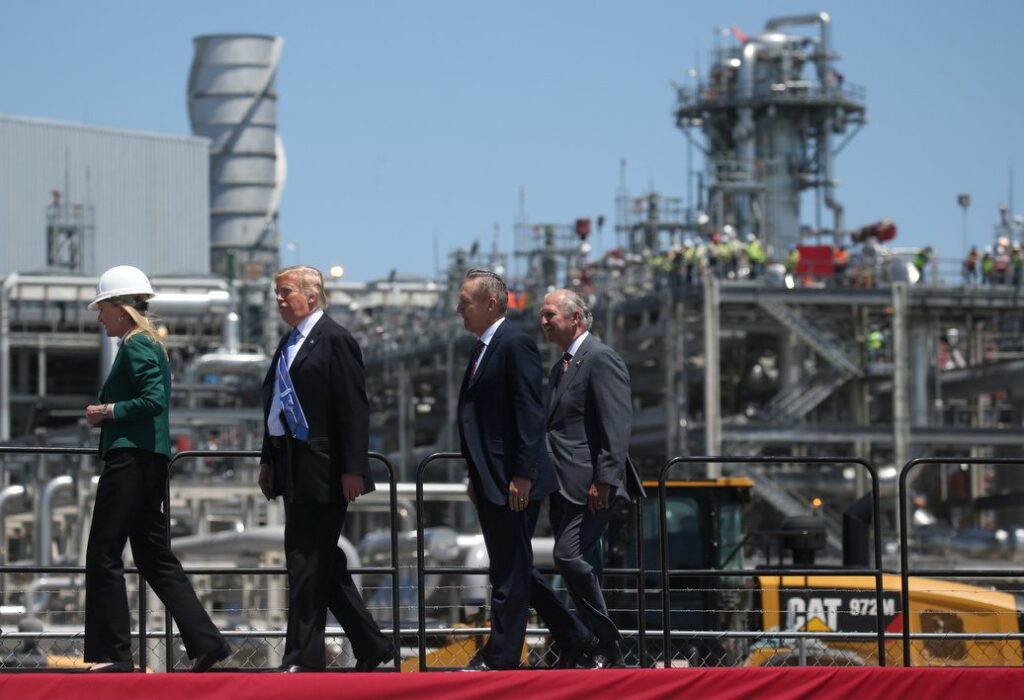
Reuters/Leah Millis
Since 2016 the US has transformed into the world’s largest LNG exporter, eclipsing Australia and Qatar. Donald Trump is now determined to achieve global energy dominance as he exploits the geopolitical leverage conferred by those exports in his relations with Europe, Asia and the GCC.
The US president has pledged to expand US natural gas production dramatically, rescinded Joe Biden’s environmental pause on new LNG projects, embraced deregulation, and pledged to transform Alaskan natural gas into a major fuel source for Asian allies like Japan, South Korea, Taiwan and the Philippines.
At a time when the US is already the world’s largest oil producer, pumping 13.5 million barrels a day (mbd) against Saudi Arabia’s 9 mbd, Trump’s ambition to increase natural gas production by 60 percent will have a significant impact on the trade flows and geopolitics of the global LNG market over the next five years.
The revolutionary technologies of horizontal drilling and hydraulic fracturing have enabled the US to produce more than 100 billion cubic feet per day. This generates a surplus that can be exported via the construction of a dozen giant LNG export terminals on the Gulf Coast.
The sheer scale of US natural gas production in the past two decades, from reservoirs in North Dakota to Texas’s Permian Basin, has meant that US prices averaged $3.50 per million BTU (British thermal unit), 70 percent below the spot LNG prices prevailing in Europe and Asia.
On the demand side, the AI revolution, sanctions on Russia even before the 2022 invasion of Ukraine, and the rising demand for electricity in the fast-growing economies of Asia have created an insatiable appetite for relatively cheap, accessible and reliable American LNG.
Europe’s chancelleries are likely to seek to diversify their energy supply by increasing imports from Qatar, Algeria, Nigeria and Angola
American LNG imports have enabled Europe to break Russia’s chokehold on pipeline gas from Gazprom’s West Siberian giant gas fields after Vladimir Putin’s 2022 invasion of Ukraine.
Europe is currently the destination of more than two-thirds of all American LNG tanker cargoes shipped from export terminals in Texas and Louisiana’s Gulf Coast ports.
However, that may change. Trump’s tariff threats, the decision to exclude the EU from peace talks with Ukraine, and a pro-Kremlin diplomatic pivot have made Germany and France nervous about their new LNG dependence on an increasingly isolationist and erratic America under Trump 2.0.
While there is no systemic threat to the transatlantic LNG trade, Europe’s chancelleries are likely to seek to diversify their energy supply by increasing imports from Qatar, Algeria, Nigeria and Angola.
Spot LNG shipments from Africa are constrained by limited production capacity while Qatari LNG cargoes have been disrupted by Houthi attacks in the Red Sea.
The threat to US market dominance is minimal unless Trump’s tariff threats escalate into a trade war with Europe. The continent has exchanged its former energy dependency on an unreliable Kremlin for a new vulnerability in the form of an unreliable Trump White House.
Asian countries which run substantial trade surpluses with the US however now have no choice but to increase LNG imports from America significantly. This was the main takeaway from Indian prime minister Narendra Modi’s state visit to Washington to protect India’s $130 billion bilateral trade.
It is the world’s fastest-growing emerging economy with 6 percent+ GDP growth but India’s population of 1.4 billion people enjoys per capita income of only $2,700. The country imports 5.4mbd of oil while its refineries are configured to process Iranian, Russian and GCC oil, whose freight costs are only $1.50 per barrel, one-third that of US oil.
American LNG imports are more efficient since freight cost efficiencies are better than for crude oil, and the super-chilled fuel can be regasified to connect to India’s power grid. It is likely to be a significant market for US LNG exports at the expense of existing GCC suppliers, led by Qatar.
Japan, South Korea and Taiwan are likely to follow India’s example and dramatically expand their imports of US LNG to offset trade surpluses.
China, the largest LNG importer in the world, imposed retaliatory tariffs on US LNG last month, but this loss of market share is likely to be amply compensated by a quantum increase in shipments to gas-guzzling economies of the wider Pacific Rim and South Asia.
The surge in American LNG exports will mean a fall in long-term prices by the late 2020s. Many Asian countries are now renegotiating their long-term supply contracts with GCC suppliers led by Qatar, which could adversely impact its epic North Field expansion plans.
Trump’s tariff threats provide them with an immediate fiscal incentive to move away from long-term supply contracts with GCC suppliers, even as long-term prices decline due to a potential LNG glut later in this decade.
Like Gulf oil, Gulf LNG faces a bearish headwind from American energy dominance.
Matein Khalid is an investor in global financial markets and board advisor to leading family offices in the UAE and Saudi Arabia



